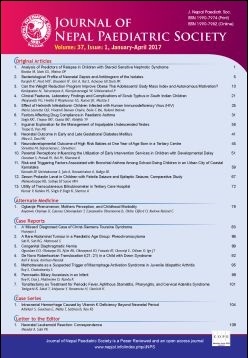Ogbanje Phenomenon; Mothers Perception, and Childhood Morbidity MORBIDITY
DOI:
https://doi.org/10.3126/jnps.v37i1.16373Keywords:
Ogbanje, Mother’s perception, Childhood morbidityAbstract
Introduction: A cultural myth Ogbanje have existed among the Ibo people of Nigeria. These children may have morbidities that are manageable while some normal children may have to live with the stigma of being labelled such. The objective of this study was to assess mother’s perception of ogbanje phenomenon and morbidity in ogbanje children.
Material and Methods: This was a Cross-sectional study amongst mothers having the concept of “Ogbanje” children who were clinically examined. SPSS version 20.0 was used for data analysis. Variables were compared with χ2. p<0.05 was accepted as significant.
Results: A total of 64.8% believed in “Ogbanje”. Commonest presentation of “Ogbanje” was frequent illness (47.3%). Only 12(3.3%) would seek orthodox care for ogbanje children. Examined “ogbanje” children had sicklecell anaemia, structural anomalies, and diabetes. Four (9.5%; n=42) children were normal.
Conclusion: Ogbanje myth still exists in the minds of mothers and affects health seeking behaviour. Ogbanje children may have manageable illness and sometimes may be normal.
Downloads
Downloads
Additional Files
Published
How to Cite
Issue
Section
License
Authors who publish with this journal agree to the following terms:
Authors retain copyright and grant the journal right of first publication with the work simultaneously licensed under a Creative Commons Attribution License that allows others to share the work with an acknowledgement of the work's authorship and initial publication in this journal.
Authors are able to enter into separate, additional contractual arrangements for the non-exclusive distribution of the journal's published version of the work (e.g., post it to an institutional repository or publish it in a book), with an acknowledgement of its initial publication in this journal.
Authors are permitted and encouraged to post their work online (e.g., in institutional repositories or on their website) prior to and during the submission process, as it can lead to productive exchanges, as well as earlier and greater citation of published work (See The Effect of Open Access).



